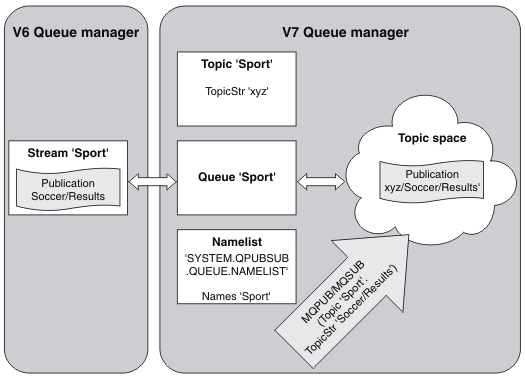Streams and topics
Queued publish/subscribe has the concept of a publication stream that does not exist in the integrated publish/subscribe model. In queued publish/subscribe, streams provide a way of separating the flow of information for different topics. From IBM® WebSphere MQ Version 7.0 onwards, a stream is implemented as a top-level topic that can be mapped to a different topic identifier administratively.
The default stream SYSTEM.BROKER.DEFAULT.STREAM is set up automatically for all brokers and queue managers on a network, and no additional configuration is required to use the default stream. Think of the default stream as an unnamed default topic space. Topics published to the default stream are immediately available to all connected queue managers from Version 7.0 onwards, with queued publish/subscribe enabled. Named streams are like separate, named, topic spaces. The named stream must be defined on each broker where it is used.
If the publishers and subscribers are on different queue managers, then after the brokers are connected in the same broker hierarchy, no further configuration is required for the publications, and subscriptions to flow between them. The same interoperability works in reverse, too.
Named streams
A solution designer, working with the queued publish/subscribe programming model, might decide to place all sports publications into a named stream called Sport. In Version 6.0 a stream is often replicated automatically onto other brokers that use the model queue, SYSTEM.BROKER.MODEL.STREAM. However, for the stream to be available to a queue manager that runs on Version 7.0 onwards with queued publish/subscribe enabled, the stream must be added manually.
Queued publish/subscribe applications that subscribe to Soccer/Results on stream Sport work without change. Integrated publish/subscribe applications that subscribe to the topic Sport using MQSUB, and supplying the topic string Soccer/Results receive the same publications too.
The task of adding a stream is described in the topic Add a stream. You might need to add streams manually for two reasons.- You continue to develop your queued publish/subscribe applications that are running on later version queue managers, rather than migrate the applications to the integrated publish/subscribe MQI interface.
- The default mapping of streams to topics leads to a "collision" in topic space, and publications on a stream have the same topic string as publications from elsewhere.
Authorities
By default, at the root of the topic tree there are multiple topic objects: SYSTEM.BASE.TOPIC, SYSTEM.BROKER.DEFAULT.STREAM, and SYSTEM.BROKER.DEFAULT.SUBPOINT. Authorities (for example, for publishing or subscribing) are determined by the authorities on the SYSTEM.BASE.TOPIC ; any authorities on SYSTEM.BROKER.DEFAULT.STREAM or SYSTEM.BROKER.DEFAULT.SUBPOINT are ignored. If either of SYSTEM.BROKER.DEFAULT.STREAM or SYSTEM.BROKER.DEFAULT.SUBPOINT are deleted and re-created with a non-empty topic string, authorities defined on those objects are used in the same way as a normal topic object.
Mapping between streams and topics
A queued publish/subscribe stream is mimicked in Version 7.0 onwards by creating a queue, and giving it the same name as the stream. Sometimes the queue is called the stream queue, because that is how it appears to queued publish/subscribe applications. The queue is identified to the publish/subscribe engine by adding it to the special namelist called SYSTEM.QPUBSUB.QUEUE.NAMELIST. We can add as many streams as you need, by adding additional special queues to the namelist. Finally you need to add topics, with the same names as the streams, and the same topic strings as the stream name, so we can publish and subscribe to the topics.
However, in exceptional circumstances, we can give the topics corresponding to the streams any topic strings you choose when you define the topics. The purpose of the topic string is to give the topic a unique name in the topic space. Typically the stream name serves that purpose perfectly. Sometimes, a stream name and an existing topic name collide. To resolve the problem, can choose another topic string for the topic associated with the stream. Choose any topic string, ensuring it is unique.
The topic string defined in the topic definition is prefixed in the normal way to the topic string provided by publishers and subscribers using the MQOPEN or MQSUB MQI calls. Applications referring to topics using topic objects are not affected by the choice of prefix topic string - which is why we can choose any topic string that keeps the publications unique in the topic space.
The remapping of different streams onto different topics relies on the prefixes used for the topic strings being unique, to separate one set of topics completely from another. You must define a universal topic naming convention that is rigidly adhered to for the mapping to work.
In Version 7.0, if topic strings collided you might use streams to separate the topic spaces.
From Version 7.0 onwards, we use the prefixing mechanism to remap a topic string to another place in topic space.
Note: When you delete a stream, delete all the subscriptions on the stream first. This action is most important if any of the subscriptions originate from other brokers in the broker hierarchy.Example
In Figure 1, topic 'Sport' has the topic string 'xyz' resulting in publications that originate from stream 'Sport' being prefixed with the string 'xyz' in the version 7 queue manager topic space. Publishing or subscribing in version 7 to the topic 'Sport' prefixes 'xyz' to the topic string. If the publication flows to a Version 6 subscriber, the prefix 'xyz' is removed from the publication and it is placed in the 'Sport' stream. Conversely, when a publication flows from Version 6 to version 7, from the 'Sport' stream to the 'Sport' topic, the prefix 'xyz' is added to the topic string.
